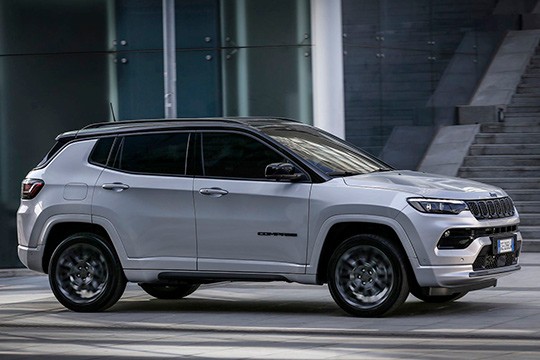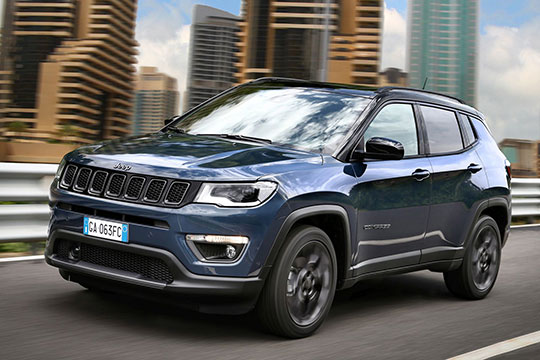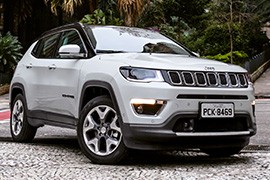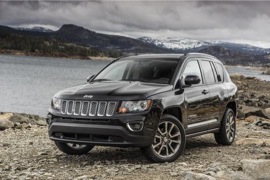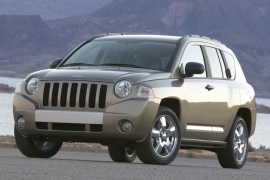JEEP Compass Models/Series Timeline, Specifications & Photos
First production year: 2006
Engines: Gasoline, Hybrid gasoline, Diesel
Body style: SUV (Sports Utility Vehicle)
Jeep introduced a significant facelift for the Compass range in 2021 and added more technology to a vehicle that could feel at home either in a parking lot or in front of a lodge in the mountains.
The second generation of the Compass debuted in 2016 in Brazil and, later on, at the Los Angeles International Auto Show. Fast forward to early 2021, and the car had to go through a major refresh. There were new emission regulations and new standards to achieve, and the Compass received a mid-life cycle refresh.
Even though it still sported the seven vertical slats on the grille, the 2021 version (launched as a 2022 model year) was more of an urban SUV than a hard-core off-roader. The car sported a new front bumper with integrated fog lights on the sides, extended towards the car's center with broad lines. Its headlights were narrower and featured LED daytime running lights at their top. From the sides, the profile remained similar but with a floating-roof design enhanced by the C-pillar's look.
Inside, it was a major refresh. The carmaker installed a 10.25" instrument cluster in front of the driver instead of classic, analog dials. On top of the center stack, mounted on the dashboard, Jeep placed the infotainment's system screen available with either an 8.4" or a 10.1" size. It was Android-based and offered wireless connection with either Android Auto or Apple CarPlay. Depending on the trim option, it offered a leather-clad interior or cloth upholstery.
Under the hood, the 2021 Jeep Compass featured a range of gasoline, diesel, or hybrid powertrains. It was ranged between 130 hp and a respectable 240 hp for the top version. They were paired to either a six-speed manual or a six-speed automatic (Dual Clutch) gearbox.
The second generation of the Jeep Compass hit the market in late 2020, and it was offered with a new, 1.3-liter, turbocharged engine.
There are just a handful of car-makers that could claim their superiority in the 4x4 industry, and Jeep is one of them. Apart from a few mishaps, all of their products featured an all-wheel-drive system since the brand was launched in 1948. The first generation of the Compass was their chance to enter in the urban crossover market in 2007. The second generation was introduced in 2016 as a 2017 model year. In 2020 it was refreshed.
Only an eye keen for details could tell the differences between the 2017 and the 2020 models. Elements such as the front bumpers, with a low-mounted radar system, and the black door-mirrors caps were just a few examples. Other than that, the exterior remained similar. Even the headlights looked the same. The rear bumper was slightly different as well.
Inside, the new Uconnect infotainment unit was changed, and it was offered with a 7” or an 8.4” touch-screen. It represented a step forward for car-connectivity via My Uconnect app. It was accessible through various touchpoints, including a mobile app, smartwatch, website, button on the ceiling, and radio.
The most significant differences were under the hood, where the 2020 Compass offered a choice of diesel and gasoline engines. The jeep dropped the 2.4-liter version and received a turbocharged 1.3-liter gasoline unit. There were three choices for diesel units.
Unveiled to the public for the first time in 2006, the Jeep Compass sold well over the years. And 10 years after its debut, the 2016 model sold better than ever.
With so many crossovers available on the market, it was hard for the small Compass to keep up, however, it was one of the most affordable choice among the others.
The 2016 model was a 5-passenger crossover that was available in two trim levels: Sport and Latitude. The Sport SE and High Altitude Edition sub-trims added features to both trim levels.
Standard features for the Sport included air-conditioning, roof rails, Bluetooth connectivity, cruise control, foglights and 16-inch alloys.
With the Latitude, the buyers were offered the Sport’s standard features and added exterior chrome accents, heated front seats, a 6.5-inch touchscreen infotainment system and upgraded upholstery.
Stand-alone options for the Sport trim level included full power accessories and some of the Latitude’s standard features.
Several packages were available for each trim level and added from a better sound system to a sunroof, bigger wheels, a rearview camera to increase safety and many others.
Safety wise, the Compass included antilock brakes, stability and traction control, frontal airbags, side curtain airbags and disc brakes in the front for the all-wheel-drive models.
For the 2011 model, Jeep gave a Grand Cherokee look to its compact SUV, the Compass. The new bodywork kept the traditional seven slots found on all Jeep vehicle grilles. But the overall Compass look has a more sophisticated appearance. The headlights are with halogen bulbs, but for the taillights, Jeep installed LED for the Limited trim model. Standard wheels are 17” light-alloy and, for the Limited trim level, 18” aluminum wheels are offered as an option.
Under the hood, the Compass received as standard a 2.0-liter gasoline engine that provides 158 hp and 191 Nm (141 lb-ft) of torque, which is coupled to a CVT transmission. Another option is the 2.4 gasoline version, which produces 172 hp and 224 Nm (165 lb-ft) of torque. When equipped with the 5-speed manual transmission, the Compass can achieve a 10.2 l/100 km (23 mpg) fuel consumption in the city and 8.1 l/100 km (29 mpg) on the highway. The model is offered either with front or all-wheel-drive on both engine variants.
Inside the cabin, five passengers have enough room, but the three people on the rear seats will be cramped. At least, they can enjoy a Uconnect media center with iPod interface, SIRIUS Satellite Radio, navigation with SIRIUS Travel Link, a power sunroof, a premium audio system with nine Boston Acoustic speakers, liftgate speakers and fold-flat rear seats for sleeping in the car, in the middle of nowhere.
JEEP Compass 2.0L FWD 5MT (156 HP)
JEEP Compass 2.0L FWD 5MT (159 HP)
JEEP Compass 2.0L FWD 6AT (159 HP)
JEEP Compass 2.4L 4x4 5MT (170 HP)
JEEP Compass 2.4L 4x4 5MT (175 HP)
JEEP Compass 2.4L 4x4 6AT (175 HP)
JEEP Compass 2.4L 4x4 CVT (170 HP)
JEEP Compass 2.4L 4x4 CVT (175 HP)
Jeep tried to broaden its portfolio and introduced the 2007 Compass at the 2006 North American Motor Show for the 2007 model year, a vehicle that targeted first-time buyers.
While the crossover and SUV segment was rising, Jeep used its prestigious heritage to attract new customers with a road-oriented vehicle that still shared some of the brand’s DNA in its look and feel. Even though it built the Compass on the same platform as the Mitsubishi Lancer, there were significant differences that made it appealing to customers. Its higher ground clearance and fresh look were meant to divert buyers from hatchbacks to Jeep’s smallest crossover. Moreover, it was even available in a 2WD version, which made it ideal for those looking for a compact vehicle good enough to park in tight spots but large enough to carry a family of four in and around town.
At the front, the Compass received the brand’s design signature with round headlights and a seven-slat grille between them. Its front fascia slightly resembled the one placed on the 2001 Jeep Liberty, which perhaps was not the best idea. On the lower bumper, the automaker placed a pair of round fog lamps, depending on the grade and options. At the same time, the angular-shaped front bumper, with taller outer sides, made a clear connection with the enlarged front fenders, which, when looked at from the front, appeared as wide shoulders.
From its profile, the hatchback styling of the vehicle was mixed with the design attributes of a crossover due to the higher ground clearance. The Compass’s enlarged wheel fenders created the image of a muscular vehicle, even though its performance was closer to that of mass-market vehicles. The automaker’s idea was to create an appealing vehicle, targeting young buyers. That’s why it placed grab handles for the front doors, while those in the rear were concealed into the C-pillars. Furthermore, a third row of triangular windows and a raised line for the rearmost posts matched the definition of a youth-oriented car. Finally, at the back, the automaker placed corner-mounted taillights that flanked the wide tailgate.
While the car’s exterior was thoroughly studied, the interior looked like it was made at the last minute. Its hard plastic materials and poor fits and finish affected the Compass’ sales. Fronting the driver was a squared instrument cluster filled with four dials, resembling those from the Wrangler. The silver plastic trims that adorned it didn’t look upscale at all. Furthermore, the squared-looking center stack sported angular-shaped vents, stereo, and a small storage space where customers could fit their mobile phones. At the lower side of the center stack, the automaker installed the gear selector/gear stick, depending on the version. Jeep also provided the Compass with a Uconnect infotainment system featuring a sat-nav and a touchscreen. Customers could also use a USB port to listen to their music from MP3 players and other devices. In the back, a split-folding (40/60) bench seat was wide enough to host three occupants on short trips or two for longer journeys. The trunk could be used to sit on it, and a pair of swing-down speakers from the tailgate, known as party speakers, were fitted with young customers in mind.
Under its skin, the DaimlerChrysler/Mitsubishi GS platform meant that the vehicle featured independent suspension in all corners, providing a comfortable ride for its occupants. Depending on the market, the Compass was powered by a choice of three engines: a 2.0-liter inline-four, a 2.4-liter four-banger, and a 2.0-liter turbodiesel carried over from Volkswagen. Later, a 2.2-liter turbodiesel from Peugeot-Citroen replaced that oil-burning version. All cars were fitted as standard with a five- or six-speed manual gearbox that sent the power to the front or in all corners, depending on the grade. A CVT was available, depending on the engine and market.
